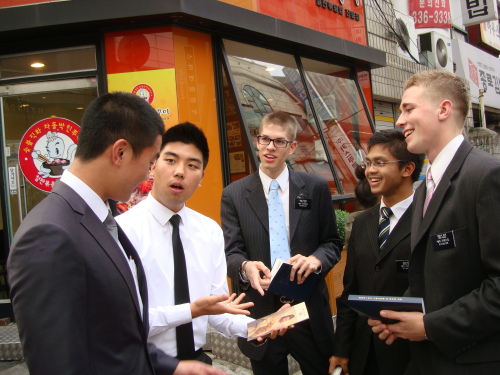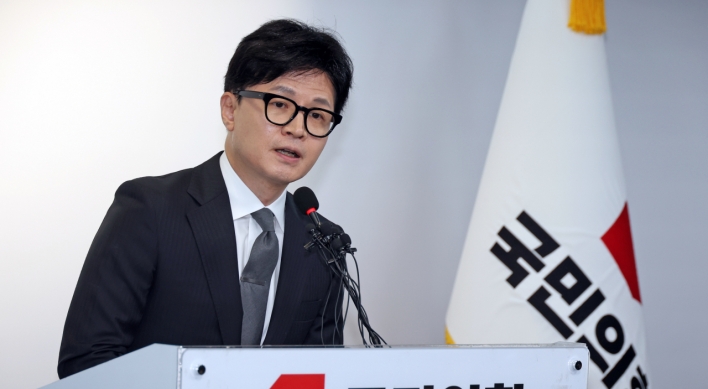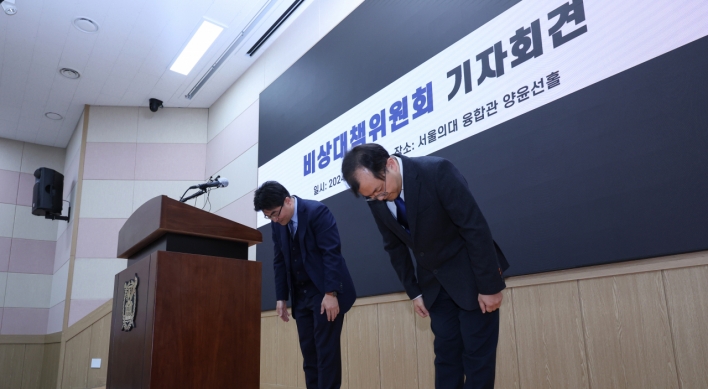“Whenever we say we’re Mormon, a lot of people think we’re polygamists,” said Elder Tyson Bailey, 21, his voice betraying a hint of exasperation.
Their frustration is understandable: The Church of Jesus Christ of Latter-day Saints banned the practice of plural marriage in 1890, about a century before the 21-year-old was born.
Elder Kellen Fowers, 20, listed more misconceptions: They don’t worship the book of Mormon, or church founder Joseph Smith, for example.
“We do not worship anything but Jesus Christ,” he said.
Of course, LDS Church members who volunteer to come here as missionaries do a lot more than refute myths about their church. They work to form friendships, to teach their faith and perform public services.
And while here, many missionaries form a long-lasting relationship with Korea.
As of December 2010 there were 52,000 LDS missionaries serving all over the world. In Korea, there are 114 based in Seoul, 60 in Daejeon and 55 in Busan.
The majority of missionaries are men in their mid-20s or younger, who nonetheless are referred to as elders. Female church members, or sisters, may take part from age 21. Senior couples may also go if their finances are in order. Missionaries come to Korea not just from the U.S., but nations as diverse as Australia, Canada, Germany, the Philippines and Mongolia.
LDS missionaries have a reputation for language acquisition, but picking a language in one’s childhood doesn’t necessarily determine where they will end up. Bailey, for example, studied Spanish. Fowers, who already has a European Studies degree, had studied both Spanish and Latin.
“That’s kind of what makes it fun, is that it’s not necessarily our decision where we go, but we get to experience a whole new culture and love the people,” Fowers said.
Once here, the missionaries follow a strict routine from day to day: up at 6:30 a.m., exercise and breakfast at 8 a.m. From then, they spend about three hours studying the Bible, church doctrine and Korean.
At 11 a.m. they have lunch, and then they head out, introducing themselves to people on the street, discussing their faith and offering them a chance to learn more. If they are interested, the missionaries can arrange to meet with them later.
Their frustration is understandable: The Church of Jesus Christ of Latter-day Saints banned the practice of plural marriage in 1890, about a century before the 21-year-old was born.
Elder Kellen Fowers, 20, listed more misconceptions: They don’t worship the book of Mormon, or church founder Joseph Smith, for example.
“We do not worship anything but Jesus Christ,” he said.
Of course, LDS Church members who volunteer to come here as missionaries do a lot more than refute myths about their church. They work to form friendships, to teach their faith and perform public services.
And while here, many missionaries form a long-lasting relationship with Korea.
As of December 2010 there were 52,000 LDS missionaries serving all over the world. In Korea, there are 114 based in Seoul, 60 in Daejeon and 55 in Busan.
The majority of missionaries are men in their mid-20s or younger, who nonetheless are referred to as elders. Female church members, or sisters, may take part from age 21. Senior couples may also go if their finances are in order. Missionaries come to Korea not just from the U.S., but nations as diverse as Australia, Canada, Germany, the Philippines and Mongolia.
LDS missionaries have a reputation for language acquisition, but picking a language in one’s childhood doesn’t necessarily determine where they will end up. Bailey, for example, studied Spanish. Fowers, who already has a European Studies degree, had studied both Spanish and Latin.
“That’s kind of what makes it fun, is that it’s not necessarily our decision where we go, but we get to experience a whole new culture and love the people,” Fowers said.
Once here, the missionaries follow a strict routine from day to day: up at 6:30 a.m., exercise and breakfast at 8 a.m. From then, they spend about three hours studying the Bible, church doctrine and Korean.
At 11 a.m. they have lunch, and then they head out, introducing themselves to people on the street, discussing their faith and offering them a chance to learn more. If they are interested, the missionaries can arrange to meet with them later.

These introductions and appointments continue until 9 p.m., at which point they return home for a night’s rest. It starts all over again the next day, unless it’s Sunday, when they’re at church, or they are involved in community service projects.
Missionaries are typically assigned into pairs, sometimes threes. Sisters Brooke Ellis, 22, and Phylicia Knapp, 21, work together, keeping to the usual schedule except for an extra hour of study because Knapp arrived just last month.
“I love how hospitable everyone is,” said Knapp, who is originally from Idaho. “You can walk down the street (in Seoul) and talk to anyone.
I think I’m a city girl at heart.”
“I’ve gotten so much happiness from the message, from the gospel of Jesus Christ I wanted to share that,” said Ellis, who is from Indiana. “To me that’s everything, all my happiness.”
A typical mission trip lasts two years, including a three-month course at the Missionary Training Center in Utah. For sisters it’s about 18 months. All of the missionaries interviewed were in their college years, save Fowers, who plans to attend medical school later.
They had a variety of long-term plans, but all believed they would maintain a connection to Korea throughout their lives.
Among LDS missionaries there’s certainly precedent for this: Former Utah Gov. Jon Huntsman spent his missionary days in Taiwan, and that experience was key in his being chosen as U.S. ambassador to the People’s Republic of China in 2009.
In this country there’s the example of Robert Holley, who first came to Korea as a missionary in 1978-80.
After serving his two years in the Busan area, Holley returned to his native land to study. However, later he decided to return to Korea to attend Yonsei University.
After finishing law school he worked for an international law firm in Korea. Today he is head of the Gwangju Foreign School as well as a regular presence on Arirang TV.
Though he continues to attend the church in Gwangju, he said he’s not really comfortable thinking of himself as an ambassador for it.
“I think of myself as being a typical everyday person,” he said. “Mormons tend to think of themselves as representatives of the church, (but) because I’m not perfect and the public eye is on me I don’t want people to see my imperfections and think of the church.”
Still, he said that despite the misconceptions that exist, the public’s perception of the church is growing warmer. This he largely attributes to famous church members; there’s Stephen Covey, author of “7 Habits of Highly Effective People” and former Massachusetts Gov. Mitt Romney, the current frontrunner for the Republican nomination for U.S. president.
“I think Koreans are more accepting of the church than they were years ago ... because of them being in the public eye they become more accepting of it,” Holley said.
Ellis, who studied some Korean in university before becoming a missionary, said that she “absolutely plans” on coming back to Korea again in the near future.
Bailey, who plans to return to Utah Valley University when his mission trip ends, thinks there will be opportunities for him to return, perhaps if he studies international business.
“I think after you serve in a place ... it’ll always have a place in your heart,” he said.
By Rob York (rjamesyork@heraldcorp.com)
-
Articles by Korea Herald



![[Exclusive] Korean military set to ban iPhones over 'security' concerns](http://res.heraldm.com/phpwas/restmb_idxmake.php?idx=644&simg=/content/image/2024/04/23/20240423050599_0.jpg&u=20240423183955)

![[Graphic News] 77% of young Koreans still financially dependent](http://res.heraldm.com/phpwas/restmb_idxmake.php?idx=644&simg=/content/image/2024/04/22/20240422050762_0.gif&u=)



![[Pressure points] Leggings in public: Fashion statement or social faux pas?](http://res.heraldm.com/phpwas/restmb_idxmake.php?idx=644&simg=/content/image/2024/04/23/20240423050669_0.jpg&u=)










